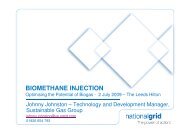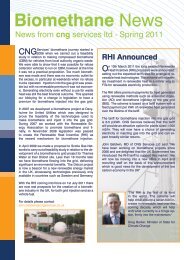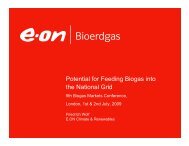Bio-SNG - CNG Services
Bio-SNG - CNG Services
Bio-SNG - CNG Services
You also want an ePaper? Increase the reach of your titles
YUMPU automatically turns print PDFs into web optimized ePapers that Google loves.
BIO-<strong>SNG</strong> FEASIBILITY STUDY – ESTABLISHMENT OF A REGIONAL PROJECTrenewable electricity and renewable transport fuels is difficult to assess objectively.This becomesimportant when the market seeks to direct biomass resources to the use that gives the greatest return forthe producer – one sector may be disadvantaged relative to another. The RTFO only applies to a fewspecific liquid fuel types and does encompass biogas – for which the only support is the fuel dutydifferential between methane and diesel/gasoline. The RTFO has had a chequered history, due to arecent slowdown in targets, as well as a drafting error, the obligation has not generally provided abankable revenue stream.The Renewable Heat IncentiveThe Renewable Heat incentive is a long overdue support mechanism to rebalance renewabledevelopment into the heat sector. This incentive includes support for direct injection of renewable gas intothe network. Following the Comprehensive Spending Review, HMT made the following press release onthe 20 Oct 2010……….. “£860 million funding for the Renewable Heat Incentive which will be introducedfrom 2011-12. This will drive a more-than-tenfold increase of renewable heat over the coming decade,shifting renewable heat from a fringe industry firmly into the mainstream. The Government will not betaking forward the previous administration’s plans of funding this scheme through an overly complexRenewable Heat levy”. From this it will be seen that the RHI has survived the spending review, albeit atan ~80% reduction in support level but that there is still some clarification to be made concerning thedetails of its operation and its implementation may be delayed beyond the original target date of April2011, provisionally to June 2011. Clearly much depends upon a detailed appraisal and clarification of theRHI concerning its potential to provide an appropriate level of support for <strong>Bio</strong>-<strong>SNG</strong> developments, andhow in detail the incentive cascades back to the <strong>Bio</strong>-<strong>SNG</strong> producer.The Feed-In TariffThe Feed-In Tariff was introduced in 2010 to incentivise the production of renewable electricity from smallfacilities, avoiding the complexities of the RO by offering a fixed but uplifted electricity selling price. TheComprehensive Spending Review indicates that the next FIT review will include changes intended tofocus development on those schemes thought to be most effective. Again it will be necessary to see ifthere are any market distorting effects that could influence competition for solid bio-fuels.EU Renewable Energy DirectiveLate in the piece has come the EU Renewable Energy Directive (RED) which comes into law formallyby the 5 th December 2010. The RED sets out targets for member states for the generation of energy fromrenewable sources across all sectors, together with mandatory definitions of legal terms, units ofmeasurement and accounting.All domestic renewable energy legislation and practice must becompatible with the RED definitions etc. otherwise it will be illegal. Clearly, the obvious discrepanciesbetween the RTFO and the remainder of the UK‟s renewables instruments must be regularised at somepoint. The RED includes a definition of biogas and it appears that <strong>Bio</strong>-<strong>SNG</strong> would fall within the terms setout in the directive concerning its eligibility as a source of renewable energy 11 . The RED also anticipates11 Unlike the UK Energy Act 2008 which does have a definitional issue which is undergoing resolution.17









